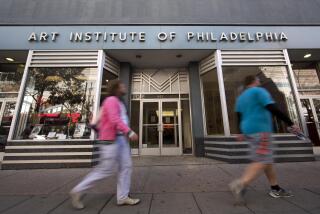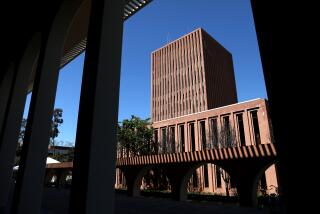Trade School Trying to Rebuild Image : United Education Hopes New Management Will Lead Firm Out of Morass of Problems
Ask Aaron Cohen, the president of United Education & Software, about the trade school business and heâll tell you about social responsibility. Heâll expound on the need to give the inner-city kid on welfare a chance to make a better life for himself.
Thatâs not the image many people might conjure up when considering trade schools. Stories abound of unscrupulous trade school operators who induce unwitting and poorly educated people to take their classes, only to provide them with shoddy instruction by unqualified teachers. Initially lured by the promise of better-paying jobs, these students often quit halfway through, disillusioned and no more employable than they were when they began.
Then there are the happy stories of disadvantaged people who establish successful careers after learning new skills at a vocational school. Take Laverne Green, a single mother who was holding down two jobs to make ends meet. She entered Pacific Coast College and emerged two years ago as a licensed vocational nurse. Green says she has a very rewarding job working with quadriplegic patients.
Cohen no doubt wishes he could spend more time promoting success stories such as Greenâs. Instead, heâs had to spend much of the past year answering a barrage of inquiries regarding problems at the Encino-based firm, which owns Pacific Coast and other trade and technical schools.
A little more than a year ago, UES was a fast-growing, profitable company. Then it all came tumbling down. A government review uncovered widespread bungling at UESâ student loan servicing subsidiary. The problems, which included failure to properly contact delinquent borrowers, led to several lawsuits and an announcement by Bank of America that it and other banks could lose as much as $650 million because of the fiasco.
Bank of America was the trustee for bonds used by California Student Loan Finance Corp., a nonprofit corporation, to buy the loans from the lending institutions that originated them.
UES has since abandoned the loan-servicing business, having sold that unit to Bank of America. But the firm is still grappling with shareholdersâ lawsuits and remains dogged by lingering negative publicity from the loan-servicing snafu.
The company, which posted $4.4 million in net income in the fiscal year that ended Jan. 31, 1988, lost $14.3 million last year and earned just $24,000 in the quarter that ended April 30. Its stock has plunged from its 1988 high of $16.375 a share to about $2, and lately there have been signs that the company could become a takeover target.
âWe had a lot of unhappy clients as a result of what happened there,â said a financial analyst who asked not to be identified. âBasically, I lost confidence in management.â
Cohen wants to talk about anything but the loan-servicing troubles these days. He said he has explained all he can on the matter: The problems stemmed from a computer system that had run amok, and yes, he admitted, someone should have minded the store more carefully.
UES is focusing on mending its bruised image and running its 25 trade schools. Bolstering efforts to turn the company around is a new management team headed by C. Ronald Kimberling, a former assistant secretary at the U.S. Department of Education and more recently executive director of the Ronald Reagan Presidential Foundation. Kimberling signed up in March as UESâ senior vice president of internal audit and governmental affairs.
He was joined by Richard P. Reinhardt, a former deputy director of the California Student Aid Commission who is United Educationâs vice president of administration, and Margaret G. Orem, another former Education Department official who joined the firm as assistant vice president of internal audit.
Bolstering Image
These management changes may smack of an attempt to gain some badly needed credibility, but observers say thatâs exactly what UES needs. The company âhas made the proper changes, perhaps too late to change the image of the company, but theyâve made the proper changes in terms of the quality of personnel,â said Jeffrey Kessler, a Shearson Lehman Hutton financial analyst.
Kimberling described his newly created position as the firmâs âsensor and radar.â His main task is to ensure that UESâ schools are in compliance with the law.
âI deeply feel that itâs got to be seen and believed that weâre trying to do the right thing,â Kimberling said. âWeâve learned and adapted to a new managementâ that wants to get âback to the basics,â he said. âWeâre into the care and feeding and nurturing of our schools.â
In addition to Kimberling, the company has a new chief operating officer, Crawford Lee Benedict. âIn the past, I used to do both,â Cohen said. âIâd be operations and Iâd be checking on myself. You canât do that anymore.â
Redeeming Reputation
Still, bad images die hard. The company âwill be under a cloud for a while,â said Boniface Zaino, manager of the TCW Value Added Fund, a mutual fund that is one of UESâ major institutional investors.
UES also is trying to stage its comeback at a time when profits donât come easily in the vocational school business. Faced with the cost of complying with tighter government regulations, coupled with a consistently low unemployment rate that makes it more difficult to attract students, many trade school operators will be forced to close their doors in the months ahead, analysts say.
âThe whole industry is finding it tough because unemployment is low,â said analyst Seth Feinstein of the investment firm Ladenburg, Thalmann & Co.
In the early 1980s, when unemployment was high and regulations were more lax, trade school firms could earn about 10 cents per dollar of revenue, Cohen said. âIn todayâs market, breaking even is very nice,â he said.
Feinstein predicted UES would break even this year, barring an upsurge in unemployment.
Vowing Persistence
But Cohen insisted heâs in the business for the long haul. While UESâ restructuring is costly and profits may be out of the companyâs grasp for some time, âWeâre committed that weâre going to make it through this period,â he said.
One way the company is doing that is by focusing on niche markets. Several under-performing schools have been sold and others consolidated, while the ones remaining aim at pockets of demand.
Its three aircraft mechanic schools, for instance, are filling a void in the airline industry. Graduates of its oceaneering school are helping repair the Exxon Valdez, the oil tanker that ran aground in Alaska. A shortage of truck drivers is spurring Cohen to consider whether to begin a trucking school.
UES also is trying to get student-loan default rates down with such new measures as requiring students to be enrolled at least five days before applying for government-backed loans.
Cost to Taxpayers
High default rates are of great concern to the Department of Education, which estimates defaults on government-guaranteed student loans will cost taxpayers $1.9 billion in fiscal 1989.
While the new regulations affect all schools whose students have government-guaranteed loans, vocational schools notoriously have the highest default rates.
Under the new rules, schools with default rates of 60% or more may be dropped from the government program and those with default rates of 40% to 60% must reduce those rates by five percentage points a year. Only schools with default rates below 20% will be unaffected.
According to a report on school default rates released Thursday by the Education Department, UESâ schools have default rates ranging from less than 2% to more than 60%. The rates were based on loans that went into default in 1988, and will be updated annually to determine whether schools are in compliance with the new regulations.
Limits Criticized
Trade school operators argue that default rates can be an unfair and misleading measure of a schoolâs performance because many schools are located in poor neighborhoods, where students are least able to repay loans on time. The alternative to allowing these people to remain untrained is to have them living on welfare or other government-supported programs, they contend.
Jeffrey Brill, general counsel at trade school operator National Education Corp., called the crackdown on default rates absolutely inconsistent with the overriding goal of providing training for needy people. âThis is what trade schools are all trying to tell Washington,â he said. âYou have to look behind the default rates.â
Nevertheless, Cohen said, government regulations will, if anything, get even tougher in the future. Part of his companyâs mission, he said, will be to anticipate and prepare for more changes.
Possible Takeover
Meanwhile, there has been speculation that the firm will be sold. AIFS, a San Francisco company that runs student foreign exchange programs, recently revealed that it owns a 5% stake in UES.
Matt Dickstein, an AIFS spokesman, said the company believes UES is undervalued and, depending on how the stock performs, might attempt a takeover. UESâ schools would fit well with AIFSâ educational programs, Dickstein said.
Cohen said the company isnât for sale, although heâd have to consider a valid offer. Yet he also said he wants to be in the trade school business forever.
âI like to help people help themselves,â he said. âItâs a wonderful business.â
More to Read
Inside the business of entertainment
The Wide Shot brings you news, analysis and insights on everything from streaming wars to production â and what it all means for the future.
You may occasionally receive promotional content from the Los Angeles Times.








